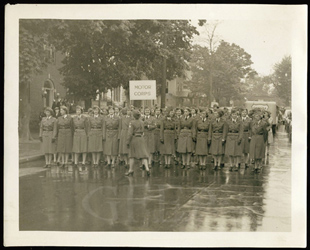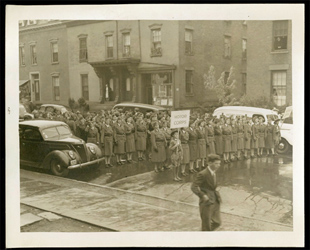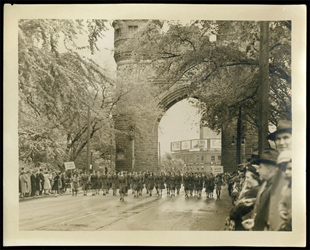WOMEN'S MOTOR CORPS, WORLD WAR I
4 PHOTOGRAPHS
$350. USD
"The Women's Motor Corps of America was established between November 1917 and January 1918 as a volunteer organization of women drivers and mechanics... The Women's Motor Corps of America was one of many offshoots of the National League of Women's service and was one of the most demanding in terms of applicants. It was also the most militaristic in terms of regimentation. Requirements were: hold a State chauffer's (driver) license and a mechanician's (mechanic's) license from an accredited mechanic's school, take the oath of allegiance, pass a medical examination conducted by an Army doctor, receive a typhoid inoculation and most importantly, own a car. They then underwent military training for one week which included infantry (close order) drill, practiced marksmanship, attended first aid, stretcher bearing, driving and mechanics classes to name a few. They would then have weekly classes in those subjects during their term of enlistment. The women were expected to not only drive but also maintain their own or assigned vehicles. Their purpose was for emergency needs and they worked closely with area hospitals in the United states. Their main task was to transport the injured and sick. Chapters near ports also met transports coming back from France and drove the wounded and sick to the hospital with which their particular chapter was associated. They also transported supplies and material for the hospitals and nearby camps. They were continually on call and had to report immediately when summoned. Failure to do so could result in discharge from the organization. It is estimated between 3,000 and 5,000 women volunteered for this organization. A small handful did go to France, but the majority did their work in the United States." (U.S. Army Transportation Museum facebook page)
PLEASE NOTE THAT THESE ARE UNMOUNTED.
SIZE. Each is approximately 8 x 10 inches.
CONDITION. 1) Photo has a few spots. Border is missing a small piece at upper left and has wear at corners. 2) Photo has a light and dark mark on the ground, between young man with baton and man walking in front of him. This appears to be in the processing or negative. Photo also has a thin mark at left side, and a few spots. Border has wear at corners and around edges. 3) Photo has a scratch at lower left, and a few spots and marks. Border has wear at corners, a bit of wear at top edge, and some soiling at left. 4) Photo has a tiny circular indentation at lower left, and a few spots and marks. Border is missing a small piece at upper left and has wear at corners.
APPEARANCE. Matte photo paper gives these a nice texture. Very good tones. Some great details on the streets, from the signage to the vehicles to the people. Significant historical content.



